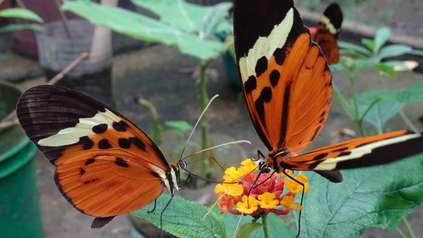Sanger joins Europe’s drive to reverse biodiversity loss through genomics research
The comprehensive application of genomic science to biodiversity research will fundamentally change conservation science and policy, with impacts predicted to be on a scale similar to those of the Human Genome Project in medicine. The new pan-European Biodiversity Genomics Europe (BGE) consortium, which includes Sanger Institute researchers, launches today (28 September). The consortium will bring together experts in DNA barcoding and genome sequencing to form the foundations for using DNA-based techniques to protect biodiversity.
One in four species on the planet are currently threatened with extinction, putting livelihoods, food supplies, and essential water and nutrient cycles at risk. Currently, our understanding of how life on Earth functions and responds to environmental pressures is far from complete. Genomics provides crucial new tools to answer these questions, and the BGE consortium will cause a quantum leap in the use of genomics across the continent.
Despite centuries of scientific research, an estimated 80 per cent of the world’s species still await scientific discovery and description. Even for described species, telling them apart is often difficult. Moreover, interactions within and among species, and between species and their environment, create a hugely complex picture from individual to planetary levels. Genomic science is our best hope for success in mapping these interdependencies and predicting how individuals and groups may respond to environmental change.
By bringing together Europe’s key practitioners in two fundamental DNA-based technologies – DNA barcoding and genome sequencing – BGE will streamline the rollout of these methods across Europe.
DNA barcoding uses short sequences of DNA to discriminate between species – analogous to the way conventional barcodes distinguish products in a supermarket. With modern genetic sequencing techniques, DNA barcoding has the potential to dramatically accelerate the inventory of life on Earth, providing a basis for global conservation monitoring.
At the opposite end of the scale, genome sequencing determines the order of DNA nucleotides – the building blocks of the genetic code – throughout the entire genome of any given species. This enables scientists to identify and locate genes and other features of the genome, creating a comparative ‘map’ of the code that creates each organism. This provides a full picture of how biological systems function and, crucially, how species respond and adapt to environmental change.
“I am enthusiastic about the prospects of connecting these two scientifically distinct communities – genomics and barcoding – together for the long term. We need to build shared sampling strategies, giving careful consideration to what samples we collect and how we collect them so they are valuable for multiple future applications. This project sets us on a path across Europe towards building better reference data sets to allow us to truly use DNA sequencing at scale to deeply understand how biodiversity changes as we make efforts to protect it. It will be very difficult to measure this adequately without DNA based techniques, so this project is key to establishing the foundation for the future.”
Dr Mara Lawniczak, Senior Group Leader at the Wellcome Sanger Institute, who worked with a small team to coordinate the successful application
Scientists in the Tree of Life programme at the Sanger Institute, together with researchers across Britain and Ireland contributing to the Darwin Tree of Life project, are sequencing the genomes of 70,000 species of plants, animals, fungi and protists.
Alongside Darwin Tree of Life, the BIOSCAN project aims to study the genetic diversity of one million flying insects from across the UK. Insects from 100 sites will be collected monthly for five years by project partners and then analysed at Sanger using DNA barcoding.
BGE will unite ongoing activities in Darwin Tree of Life and BIOSCAN with the wider biodiversity genomics activities happening across Europe. Sanger scientists and their Darwin Tree of Life collaborators are leading the way in sequencing species genomes for the first time, in terms of both large scale and high throughput, and their contributions will accelerate the work of BGE.
“The Biodiversity Genomics Europe project is an important step in the journey that we in the Tree of Life programme are on. We would like to see the development of biodiversity genomics across the globe. Our involvement in BGE means that we can play our part in expanding our vision to the whole of our continent and build the systems that will sequence all life – for the conservation of species and ecosystems, for improving the sustainability and health of human societies, and for discoveries that will shape fundamental new science.”
Dr Mark Blaxter, Programme Lead for the Tree of Life programme at the Wellcome Sanger Institute
The EU’s Biodiversity Strategy for 2030 and the European Green Deal make clear commitments to address challenges such as pollinator decline, the deterioration of key terrestrial, freshwater and marine habitats, and the impact of invasive non-native species on biodiversity. The Horizon Europe-funded BGE Consortium – a major investment in European genomic science – provides the means to achieve these aims.
“We see BGE as a mechanism through which we can go out from the limitations of national investments that we already have in biodiversity genomics and into the European level. We are looking at BGE as a mechanism to build the economies of scope and scale that we need for the future.”
Dr Dimitris Koureas, Director of the Biodiversity Genomics Europe (BGE) project, based at the Naturalis Biodiversity Center, The Netherlands
“This vital European coalition brings together diverse expertise and infrastructure across two emerging technological streams using the power of DNA and genomic science to help understand and conserve biodiversity, providing the means to tackle some of the biggest challenges facing the planet today.”
Professor Pete Hollingsworth, Director of Science at the Royal Botanic Garden Edinburgh
BGE will also collaborate with the Earth BioGenome Project and International Barcode of Life.
More information
Notes to Editors:
The €21 million Biodiversity Genomics Europe (BGE) Project (biodiversitygenomics.eu) is co-funded by the European Commission, as well as the UK and Swiss governments. This first large European project will run until 2026. It brings together organisations from the BIOSCAN Europe DNA-barcoding consortium (104 partner institutions across 29 countries) and the ERGA genome-sequencing consortium (709 members across 37 countries).
BIOSCAN Europe brings together existing European national networks, scientists and projects that work on the monitoring of biodiversity using DNA to build an efficient European system of interconnected facilities for rapid identification and monitoring of species. The initiative is part of the International Barcode of Life Consortium (iBOL) and its global BIOSCAN initiative, which aims to transform understanding of species diversity, their interactions, and dynamics. BIOSCAN Europe’s aim is to establish a European hub for the International Barcode of Life consortium.
The European Reference Genome Atlas (ERGA) initiative is a pan-European scientific community of experts in genome sequencing that aims to coordinate the generation of reference-quality genomes for all eukaryotic European species. ERGA follows a distributed model to create and consolidate a collaborative and interdisciplinary network of scientists across Europe and associated countries. ERGA works to develop and propagate guidelines for scaling up all the steps required for state-of-the-art reference genome generation through training and knowledge transfer.
Visit www.bioscaneurope.org and www.erga-biodiversity.eu for more details on the individual members of both networks.





